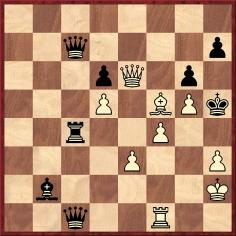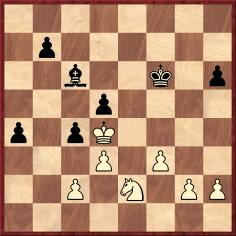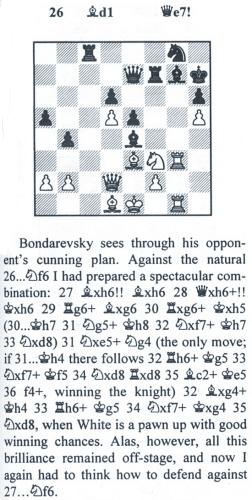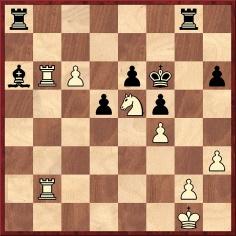Chess Notes
Edward Winter
When contacting us by e-mail, correspondents are asked to include their name and full postal address and, when providing information, to quote exact book and magazine sources. The word ‘chess’ needs to appear in the subject-line or in the message itself.
| First column | << previous | Archives [82] | next >> | Current column |
7063. A letter from Alekhine
From page 376 of the 14 July 1938 issue of CHESS:
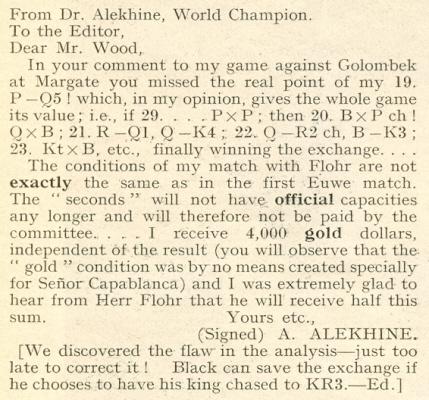
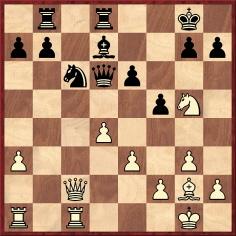
The position in the Alekhine v Golombek game (before 19 d5) had been given on page 360 of the 14 June 1938 CHESS, with this note:
‘Black might well have tried capturing the pawn, e.g. 19...PxP 20 R-Q1 Kt-K2 21 P-K4?! P-KR3 with some freedom.’
On the same page CHESS indicated the time taken on the game: one hour by White and two hours by Black.
Alekhine’s remark on the projected match with Flohr was in response to this paragraph on page 337 of the 14 June 1938 CHESS:
‘Dr Alekhine and Flohr have signed a contract for a world’s championship match in the autumn (fall) of 1939. The match will be played at various places in Czechoslovakia and the financial and other conditions are to be exactly the same as for the Alekhine-Euwe matches.’
7064. Heftye v Mieses
C.N. 127 (see page 31 of Chess Explorations) gave the game J.G. Heftye v J. Mieses. According to our source (page 328 of the Times Literary Supplement, 31 October 1902), it had been played in Sweden that year, no further particulars being indicated. The moves:
1 e4 e5 2 Nf3 Nc6 3 Bc4 Nf6 4 Nc3 Bc5 5 d3 d6 6 Be3 Bg4 7 Bb5 Bb6 8 Bg5 O-O 9 Nd5 Nd4 10 Bc4
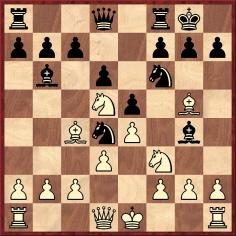
10...Nxd5 11 Bxd8 Nf4 12 O-O Raxd8 13 c3 Nxf3+ 14 gxf3 Bh3 15 a4 d5 16 Bxd5 Rd6 17 Kh1 Bg2+ 18 Kg1 Rg6 19 White resigns.
Calle Erlandsson (Lund, Sweden) finds that the game was published, with annotations, on page 217 of the October 1902 Tidskrift för Schack. The Swedish magazine stated that it took place on 11 September 1902 at the Kristiania Chess Society. The Times Literary Supplement was thus incorrect to refer to Sweden, the game having been played in the Norwegian capital.
Our correspondent has supplied the details of Mieses’ tour of Scandinavia (Kristiania, Stockholm, Göteborg and Copenhagen) as published on the two preceding pages of Tidskrift för Schack. Below are his engagements during the first leg of the tour, in Kristiania:
10 September 1902:
Simultaneous display (+17 – 3 =1);
11 September 1902 (morning):
Seven games against three players (+6 =1);
11 September 1902 (afternoon):
Four consultation games (+2 =1 and one unfinished);
12 September 1902 (morning):
Two simultaneous displays (three games each, with the score +4 –1 =1);
13 September 1902 (evening):
Blindfold simultaneous display lasting 5½ hours (+4 –1 =1).
On the basis of the results listed for 11 September, it is still unclear whether or not Heftye v Mieses was an individual game.
7065. Sponsors/backers
Myron Samsin (Ottawa, Canada) asks whether a list has ever been compiled of sponsors/backers of pre-FIDE world championship matches.
7066. Gisela K. Gresser
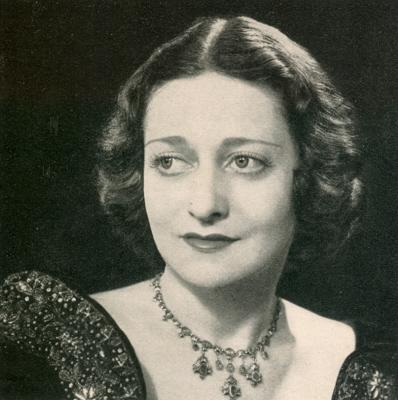
This photograph of Gisela Kahn Gresser comes from page 52 of The Year Book of the United States Chess Federation 1944 edited by Montgomery Major (Chicago, 1945).
John Blackstone (Las Vegas, NV, USA) draws attention to an article about her on page 29 of the New York Post, 10 September 1945. We reproduce her views on women’s chess:
‘The usual reason given for men being better players is that chess has been a man’s game for centuries and they’ve had more time ... There may be physical reasons too. There’s great strain involved in tournament chess, and men have more physical endurance than women, as well as more discipline and concentration.
I think maybe the reason they have more concentration ... is that women are too intelligent. They have more important things to do than play chess. To be a really great player you have to give up your whole life to it. Why, I know a musician who started playing chess and it kept him away from home so much that his wife left him. He got fewer and fewer musical engagements and after a while he never knew where his next sandwich was coming from. Now you know women are too realistic for that. But I must say ... he was happy.’
As regards her own chess career (at that time she was the US women’s champion) she stated:
‘I’m afraid ... that chess fascinates me more than anything – and I hate to admit it. I consider it an art, but one of the lower arts. To spend so much time on something that’s not really constructive hurts my conscience. I don’t spend all my time on it ... but I could.’
7067. Unique best move (C.N. 6066)
Noting that Tarrasch is sometimes attributed the suggestion that in every chess position there is a unique best move, Ingo Althöfer (Jena, Germany) asked in C.N. 6066 where Tarrasch made such a statement in print.
He now points out the following:
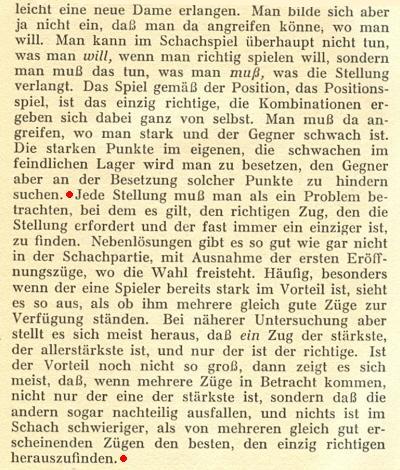
Das Schachspiel by S. Tarrasch (Berlin, 1931), page 306
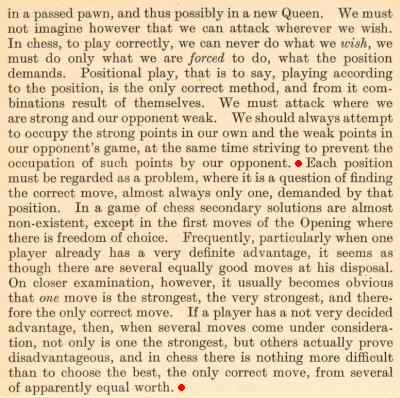
The Game of Chess by S. Tarrasch (London, 1935), page 217.
7068. Daniel Starbuck
Alan Smith (Manchester, England) notes two further games played by Daniel Starbuck and found thanks to the Jack O’Keefe Project at the Chess Archaeology website:
Dr A. – Daniel F.M. StarbuckCleveland (date unknown)
Scotch Game
1 e4 e5 2 Nf3 Nc6 3 d4 exd4 4 Nxd4 Bc5 5 Be3 Qf6 6 c3 Nge7 7 Bb5 O-O 8 Nxc6 bxc6 9 Bxc5 cxb5 10 O-O d6 11 Be3 Bb7 12 Nd2 Rfe8 13 f3 Ng6 14 a4 a6 15 axb5 axb5 16 Rxa8 Rxa8 17 Bd4 Qg5 18 Qe1 Nh4 19 g3 f5 20 Be3 Qg6 21 Kh1
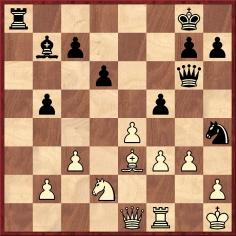
21...fxe4 22 gxh4 exf3 23 Rf2 Re8 24 Nf1 Re4 25 Ng3
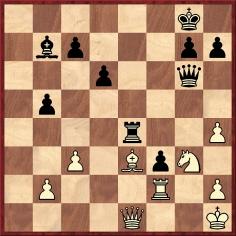
25...Rxe3 26 Qxe3 Qb1+ 27 Nf1 Qxf1+ 28 Rxf1 f2+ and mate next move.
Source: St Louis Globe Democrat, 7 August 1881.
Daniel F.M. Starbuck – Max JuddSt Louis, 1881
Bird’s Opening
1 f4 d5 2 e3 Nf6 3 Nf3 e6 4 b3 c5 5 Bb2 Nc6 6 Be2 Be7 7 d3 O-O 8 Nbd2 b6 9 Ne5 Nxe5 10 fxe5 Nd7 11 c4 Bb7 12 Bf3 Qc7 13 d4 Bg5 14 Qe2 Rad8 15 Rc1 dxc4 16 bxc4
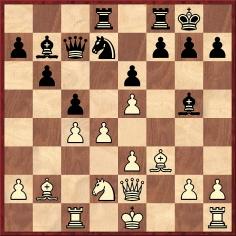
16...Bxf3 17 gxf3 cxd4 18 exd4 Nxe5 19 Rg1 Bxd2+ 20 Kxd2 Ng6 21 Ke1 Qe7 22 Qf2 Rc8 23 c5 e5 24 dxe5 Nxe5 25 Kf1 f6 26 cxb6 Rxc1+ 27 Bxc1 Nd3 28 Qe3 Qxe3 29 Bxe3 axb6 30 Bxb6 Ra8 31 Rg2 Rb8 32 Be3 Rb1+ 33 Ke2 Ne5 34 f4 Nc4 35 Kd3 Nxe3 36 Kxe3 Kf7 37 Kd3 g6 38 Re2 Rf1
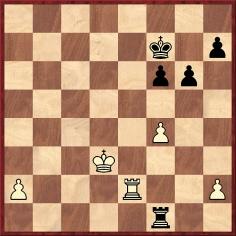
39 a4 Rxf4 40 Ra2 Rb4 41 a5 Rb7 42 a6 Ra7 43 Kc4 Ke6 44 Kb5 f5 45 Kb6 Ra8 46 Kb7 Rf8 47 a7 f4 48 a8(Q) Rxa8 49 Rxa8 Ke5 50 Kc6 f3 51 Re8+ Kd4 52 Kd6 f2 53 Rf8 Ke3 54 h4 Ke2 55 Ke6 f1(Q) 56 Rxf1 Kxf1 57 Kf6 Kg2 58 Kg7 Kg3 59 Kxh7 Drawn.
Source: St Louis Globe Democrat, 22 January 1882.
7069. Staunton’s humour (C.N.s 1283 & 1305)
C.N.s 1283 and 1305 (see pages 245-246 of Chess Explorations) discussed Staunton’s sense of humour (‘was his lacerating prose sometimes mere drollery?’).
From page 209 of the July 1899 BCM (in an
obituary of G.A. MacDonnell by J.G.C.):
‘Staunton himself was a talker of repute; his stories were well told, his anecdotes pointed, and his humour flowed freely, albeit the stream might be somewhat turgid, and there was a general air about him which seemed to say, “When I ope’ my lips let no dog bark”.’
The example given in C.N. 1283 was from page 48 of the 1849 Chess Player’s Chronicle (a note after 1 d4 e6 2 e4 d5 3 exd5 Qxd5):
‘The only advantage of taking the pawn thus, instead of in the way recommended by common sense, is that being likely to involve you in difficulties, it affords a charming opportunity for the display of ingenuity in extricating yourself afterwards.’
7070. Marion Murray (C.N. 6561)
Olimpiu G. Urcan (Singapore) submits a cutting from page 18 of the Niagara Falls Gazette of 16 August 1926:
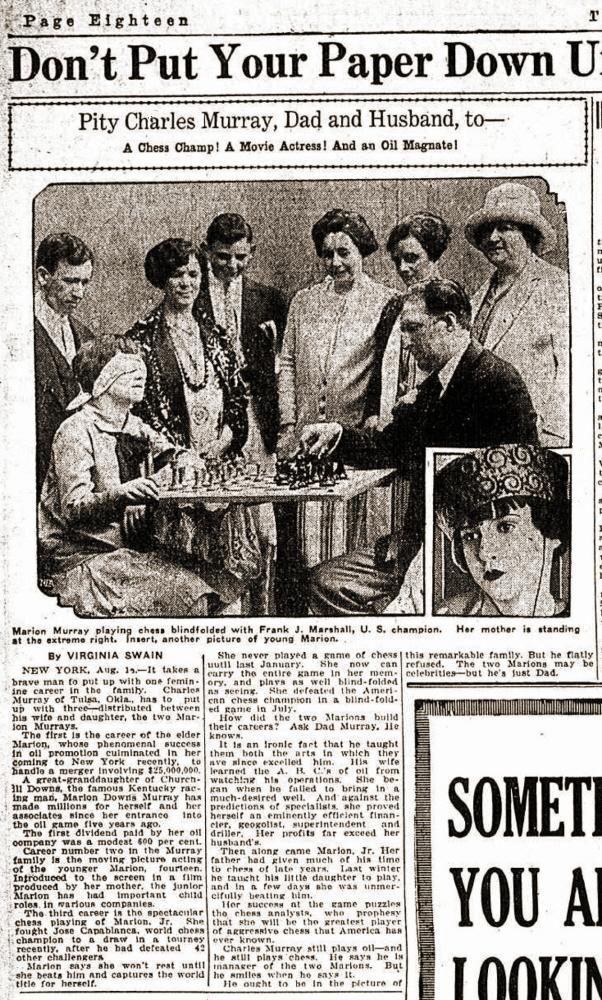
Our correspondent adds:
‘H.R. Bigelow’s column in the New York Evening Post of 30 June 1926 noted that Marion Murray was active at the Marshall Chess Club, playing, for instance, in a rapid transit handicap tournament and winning third prize behind A. Pinkus and C.S. Howell:
“The third prize was won by Miss Marion Murray, aged 12, of Tulsa, Okla. Champion Marshall was impressed by her grasp of the game and remarked afterward that with a little careful coaching she might easily become a serious rival to the present American lady champion, Mrs Natalie Nixdorff”.’
7071. Chess School
Daniel Naroditsky (Foster City, CA, USA) notes a number of failings in the Chess School series of books published by the Russian Chess House. The present item quotes his comments on three positions from Chess School 3 The Manual of Chess Combinations by Alexander Mazja (Moscow, 2003):
1) Page 77 (position 371): Lipnitsky v Smyslov, Moscow, 1950 (variation):
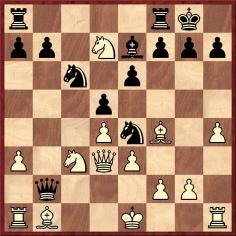
‘The book’s solution is 1 Nxe4 dxe4 2 Ra2 Bb4+ 3 Kd1 Qxa2 4 Bxa2 exd3 5 axb4 Rfd8 6 Ne5 Nxb4 7 Bb1 and “White stands slightly better”.
First of all, 1 Nxe4, to which the book awards an exclamation mark, is by no means better than the simple 1 Nxf8, which leads to an advantageous position after 1…Qxf2+ 2 Kd1. In addition, 6 Ne5 and 7 Bb1 are both erroneous, squandering White’s sizable advantage. Instead, 6 Nc5, attacking b7 as well as d3, is much better, and the passive 7 Bb1 in the solution should be replaced by 7 Bc4, preventing 7…f6.’
2) Page 78 (position 373): Evdokimov v Ragozin, ‘SSSR, 1955’:
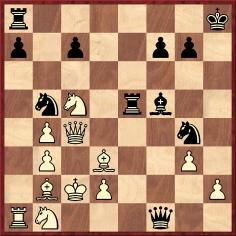
‘The solution (which was the play in the actual game) is given as: 1…Qe2 2 Qxb5 Ne3+ 3 Kc3 Rxc5+ 4 bxc5 Nd5+ 5 Kd4 Qg4+ 6 Kxd5 Bxd3 7 Qa4 Rd8+ and wins. However, a much quicker way to win is 6…Be6+ 7 Kc6 Qf3+ 8 Be4 Qxe4+ 9 Kxc7 Rc8+ 10 Kd6 Qd5+ 11 Ke7 Qd8 mate.’
3) Page 79 (position 384): Fairhurst v Kashdan, ‘Folkstown’ [Folkestone], 1933:
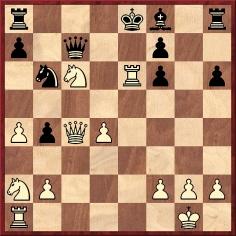
‘The solution is given in the book as:


The absence of signs for captures and for check exacerbates the problem. The solution is nonsense, with ‘...fe’ given twice. The move 1…fxe6 is wrong, as White wins after 2 Qxe6+ Be7 3 Re1 with a deadly attack.’
We add below the relevant part of Kashdan’s own annotations, on page 15 of the Book of the Folkestone 1933 International Chess Team Tournament (Leeds, 1933):
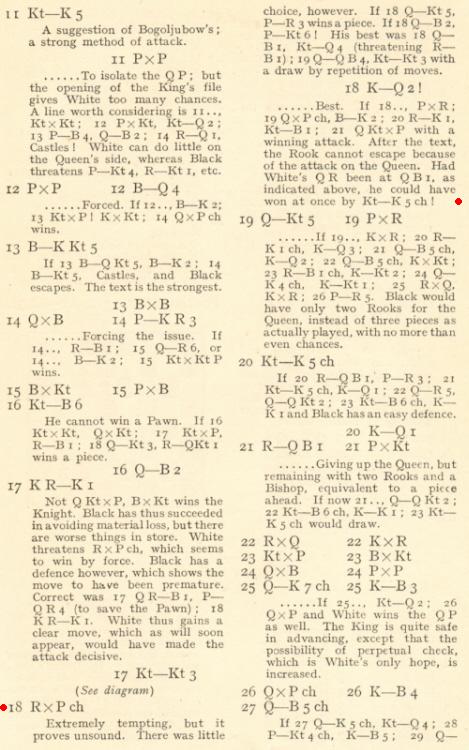
7072. Isaac Kashdan and Groucho Marx (C.N. 6180)
In C.N. 6180 Gene Gnandt (Houston, TX, USA) gave a YouTube link to Isaac Kashdan’s appearance on the television show You Bet Your Life, presented by Groucho Marx.
That link no longer works, but our correspondent provides a replacement one, to the Internet Archive.
7073. Alekhine v Keres (C.N. 7055)
From Javier Asturiano Molina (Murcia, Spain):
‘Page 140 of the October 1942 Deutsche Schachzeitung gave the opening moves as 1 Nf3 Nf6 2 c4 b6 3 d4 Bb7, and the later sequence as 10...Rc8 11 Rc1 c5 12 e3 Rc7. The same version was provided by Ramón Rey Ardid when he annotated the game on pages 285-286 of Ajedrez Español, October-November 1942.’
7074. Kurt Daluege
Jan Kalendovský (Brno, Czech Republic) sends a photograph of the Nazi official Kurt Daluege (1897-1946):
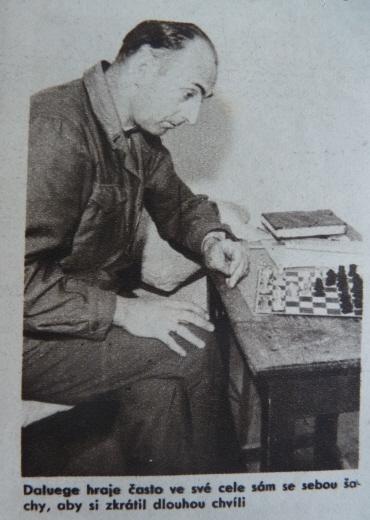
Source: Svět v obrazech, 13 October 1946, page 7. The caption states that he often played chess by himself in his prison cell, to alleviate the boredom.
Later that month, Daluege was hanged. He had been the Deputy Reich Protector of Bohemia and Moravia, in succession to Reinhard Heydrich (1904-42). The latter, we add, was featured on the front page (page 81) of the June 1942 issue of the Czech magazine Šach, following his assassination.
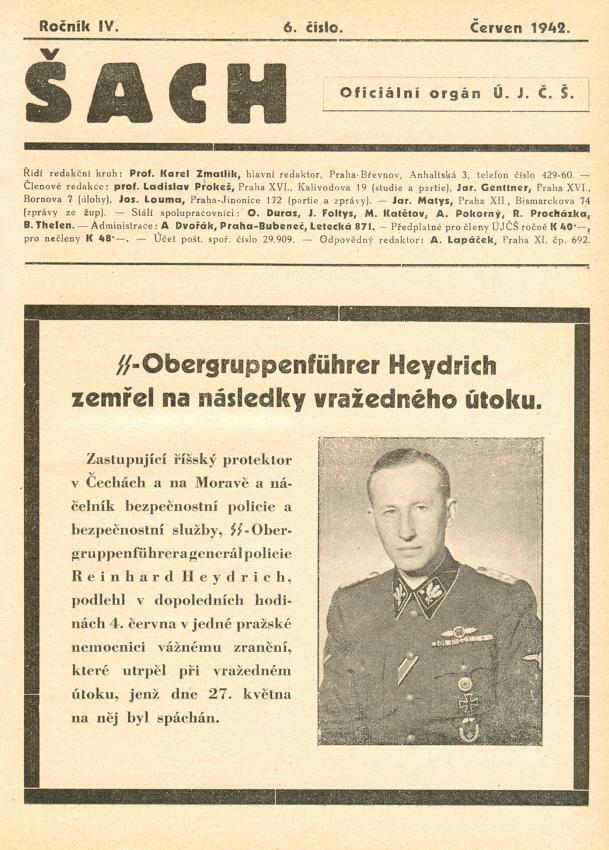
7075. A letter from Bent Larsen
C.N.s 4973 and 5003 discussed the so-called ‘Lilienthal system’ in adjournment analysis: firstly seeking a means of drawing and then looking for a possible win. Now, Christian Sánchez (Rosario, Argentina) draws attention to a letter from Bent Larsen dated 24 January 1984 and published on page 239 of the February 1984 issue of Ajedrez de Estilo:
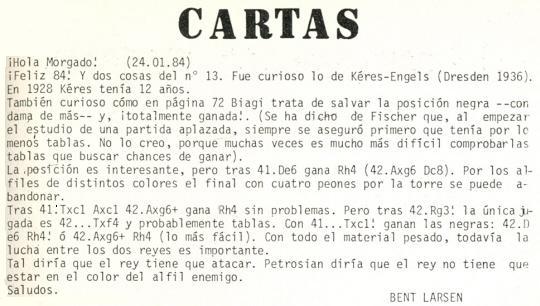
Larsen wrote:
‘It has been said of Fischer that when he began to study an adjourned game he would always first ensure that he had at least a draw. I do not believe it, because often it is much more difficult to check for drawing lines than to look for winning chances.’
Larsen’s comments about the game between Eduardo Biagi and Humberto Borghi (the conclusion of which had appeared on page 72 of the December 1983 issue of the Argentinian magazine) are also of interest. The game was played in a tournament in Buenos Aires (September 1983) in which the players had one hour for all their moves. Below is the relevant part of the tournament report:
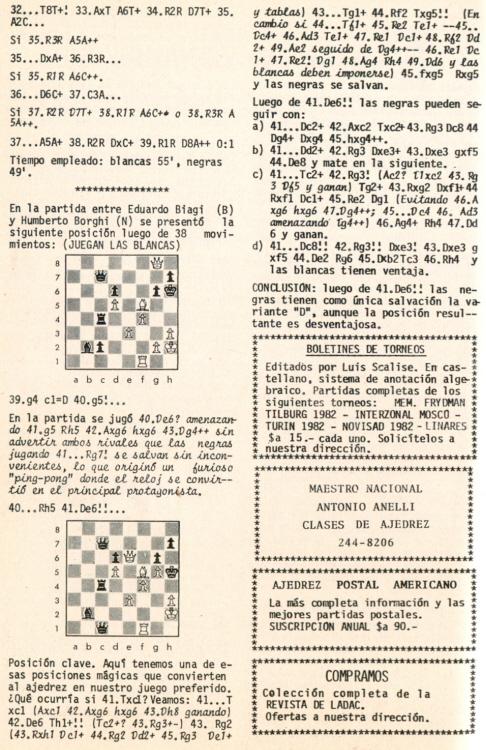
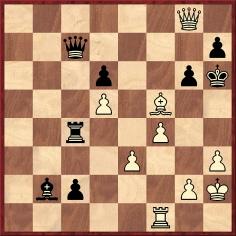
In this position play continued 39 g4 c1(Q)
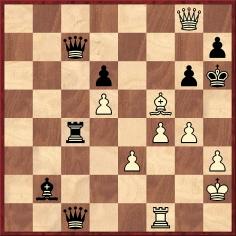
40 Qe6, threatening 41 g5+ Kh5 42 Bxg6 hxg6 43 Qg4 mate.
Neither player noticed that Black can save himself with
41...Kg7. Instead, it was recommended in the magazine,
White should have played 40 g5+ Kh5 41 Qe6, after which
four variations were given. Of these, it was stated, only
(d) would give Black any hope of salvation: 41...Qc8 42
Kg3 Qxe3+ 43 Qxe3 gxf5 44 Qe2+ Kg6 45 Qxb2 Rc3+ 46 Kh4. It
was not indicated exactly how the game ended.
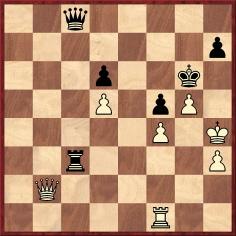
In his letter Larsen wrote:
‘The position is interesting, but after 41 Qe6, 41...Kh4 wins (42 Bxg6 Qc8). On account of the bishops of opposite colours, the ending with four pawns for the rook can be resigned.
After 41 Rxc1 Bxc1 42 Bxg6+, 42...Kh4 wins without any problems. But after 42 Kg3! the only move is 42...Rxf4, with a probable draw. With 41...Rxc1! Black wins: 42 Qe6 Kh4! or 42 Bxg6+ Kh4 (the easiest). With all the heavy material, the battle between the two kings is still important.
Tal would say that the king must attack. Petrosian would say that the king must not be on a square of the same colour as the enemy bishop.’
7076. Hollywood
A brief article on page 97 of the April 1950 Chess Review had photographs of Jeff Chandler, Marta Toren (Märta Torén) and Donald O’Connor:
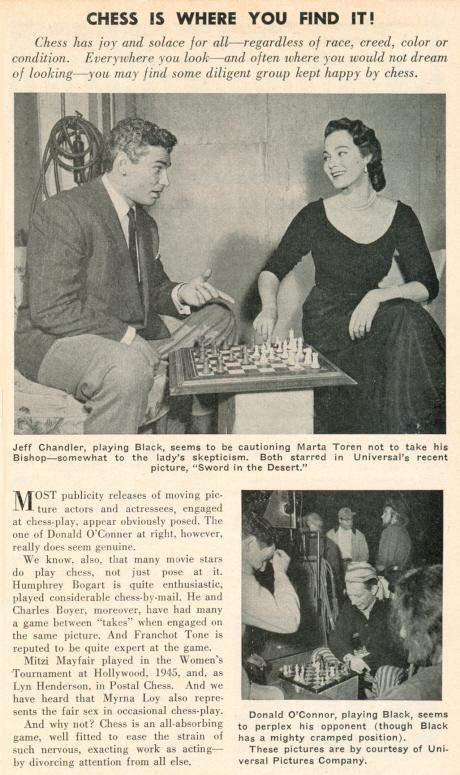
The item also referred to Franchot Tone and Myrna Loy, and we add the following from page 223 of the October 1937 Chess Review:
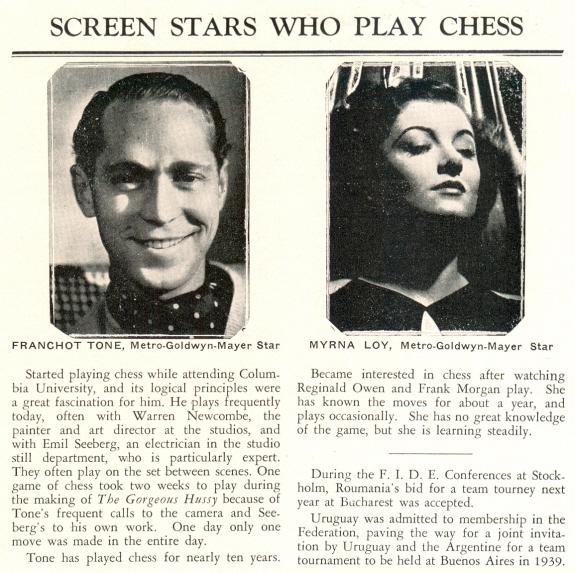
The largest pictorial feature on Hollywood and chess that we have seen is on pages 26-35 of the October 1945 Chess Review, in connection with the Pan-American Congress (won by Reshevsky ahead of Fine). The film stars included Marlene Dietrich:
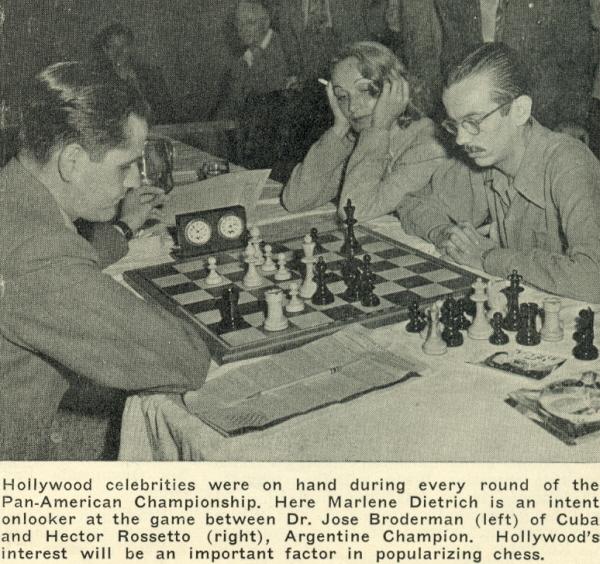
The complete article is reproduced here, the illustrations being as follows:
Page 26: Barbara Bates, Dawn Kennedy, Julie London, Jean Trent.
Page 27: Reuben Fine, Carmen Miranda, J. Edward Bromberg, José Joaquín Araiza, Herbert Seidman
Page 28: Samuel Reshevsky
Page 29: Playing room
Page 30: Roseanne Murray, Herman Steiner, Samuel Reshevsky, Weaver Adams, Marlene Dietrich, José Broderman, Héctor Rossetto
Page 31: Mitzi Mayfair, Héctor Rossetto, Mary Bain, Mrs Harmath, Mrs von Sternberg, N. May Karff, Miss Roos, Linda Darnell, Roseanne Murray, Reuben Fine, Isaac Kashdan
Page 32: Al Horowitz, Fritz Lang, Nigel Bruce, Basil Rathbone
Page 33: Herman Pilnik, Samuel Reshevsky, Reuben Fine
Page 34: Living chess; Earl Carroll girls
Page 35: Barbara Hale, Bill Williams, Linda Darnell.
7077. Back-rank mate
Pages 65-66 of A Chess Omnibus (see also C.N. 5594) discussed this game: 1 e4 e5 2 f4 exf4 3 Nf3 g5 4 Bc4 g4 5 Bxf7+ Kxf7 6 Ne5+ Ke6 7 Qxg4+ Kxe5 8 d4+ Kxd4 9 b4 Bxb4+ 10 c3+ Bxc3+ 11 Nxc3 Kxc3 12 Bb2+ Kxb2 13 Qe2+ Kxa1
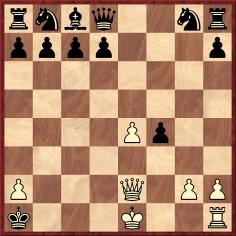
14 Kf2 mate.
We noted that according to page 120 of Robert Timmer’s Startling Castling! (London, 1997) White played 14 O-O mate. That book gave White’s name as F.C. Spencer, with no other details. When the game appeared on page 159 of the May 1894 Deutsche Schachzeitung White was identified as J. Spenser of Minnesota. Giving the score (also with 14 Kf2) on page 200 of its July 1917 issue, the BCM offered no players’ names or occasion, but the score was said to be derived from the Illustrated Sporting and Dramatic News of 1894. It appeared in the 1895 book Chess Sparks by J.H. Ellis, headed only ‘Played at Mineapolis [sic] Chess Club, about 1894’.
Ian Matthew (Portsmouth, England) has now found the game on page 1 of the North Otago Times of 23 May 1894: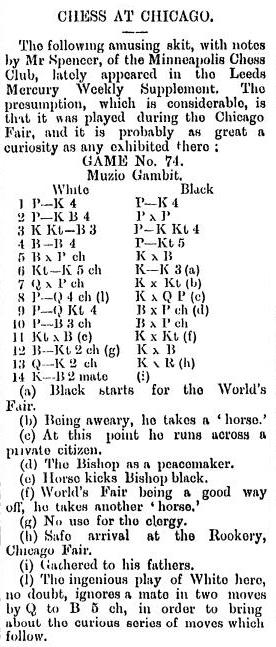
Our correspondent points out that the Leeds Mercury reference is to the issue of 4 November 1893 (page 7) and that the game was also published in the Manchester Times of 15 December 1893, page 7, and on page 8 of the Bristol Mercury of 23 December 1893. Below is the last of these columns:
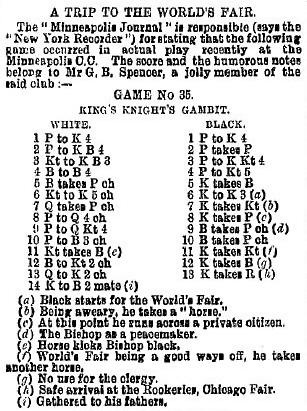
It may be recalled that G.B. Spencer was the sometime editor of the St Paul’s Dispatch. Jeremy Gaige’s Chess Personalia (Jefferson, 1987) lists George Burt Spencer (1862-1958).
Can the game’s publication in the Minneapolis Journal (mentioned in the Bristol newspaper) be traced?
7078. Frank Norton
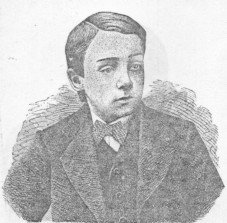
Frank Norton
Concerning the prodigy Frank Norton (see page 366 of A Chess Omnibus and pages 222-224 of Chess Facts and Fables) Olimpiu G. Urcan (Singapore) writes:
‘Jeremy Gaige’s Chess Personalia suggests that Frank Norton was born on 1 November 1866, possibly in England, with his date of death unknown. Page 1708 of the 19 January 1878 Scientific American Supplement noted that Frank Norton was 11 years old and had moved with his family from Des Moines, Iowa, to Council Grove, Kansas.
Following research into US census data, I believe Frank Norton to be the son of Dennis Norton (who appears to be the “D.P. Norton” mentioned in the Scientific American Supplement) and his wife Mary.
The 1880 US Census indicates that Dennis Norton was aged 54 (estimated date of birth 1826, in Ireland). He was listed as a grain dealer and was married to the 47-year-old Mary Norton (also of Irish origin). In their household that year, in Burlington, Des Moines, Iowa, were their seven children: John (23), Eddy (21), Mary (18), William (16), James (13), Frank (11) and Katie (8). According to the census data, Frank was born in 1869 in Iowa, which, if correct, makes him slightly younger than has been stated in several previous accounts.
His entry in the 1910 US Census reveals that he married Lillian Norton (often written “Lilian” or “Lilly” on several census forms and various other online collections of documents). Her father, Charles Miller, was French and her mother was a resident of Iowa. Their marriage is also confirmed by the Iowa Marriages, 1809-1992 database (available through FamilySearch.org), as having taken place in Burlington on 15 November 1904.
According to the 1910 Census, the couple had two sons: Dennis (four) and William (two), both born in Iowa. The family lived in Burlington, Ward 2, Des Moines. Frank Norton’s profession was given as “city auditor”. The 1920 US Census listed him as an “insurance agent” and, as was also the case in subsequent census lists, William was not mentioned.
Frank Norton’s 1915 entry in the Iowa State Census Collection (1836-1925) provided other details: his middle name began with C; he was educated for eight years at a grammar school and had three years of college education, his profession was given as “revenue inspector”, he was a Catholic, and he had served in the Spanish-American War (artillery).
The 1930 US Census listed Frank C. Norton’s profession as “insurance salesman”. According to Iowa Deaths and Burials, 1850-1990, Frank C. Norton died in Burlington on 19 October 1930.
The 1930 US Census also listed his son, Dennis Edward Norton, whose profession was “railroad shop apprentice”.’
7079. Shostakovich and Alekhine (C.N. 6654)
C.N. 6654 gave a photograph of Dmitri Shostakovich at the chessboard and quoted from pages 109-110 of Shostakovich A Life by Laurel E. Fay (Oxford, 2000):
‘Chess was chiefly a youthful infatuation; although he followed match play, he was never as serious a competitor as Prokofiev or David Oistrakh. In old age one of the favourite yarns he liked to retell was how, as a callow teenager, he had challenged and lost to Alexander Alekhine, something which could have taken place only before the future world champion left Russia for good in the spring of 1921.’
We noted that the source for this information was given on page 310:
‘M. Dolgopolov, “Budem znakomï – Alekhin ...”, Izvestiya, 17 August 1974, 5. Among others who recall hearing the composer recount versions of this story are Yevgeniy Dolmatovsky and Mstislav Rostropovich.’
Now, Marcelo Sibille (Montevideo, Uruguay) mentions that a longer account of the meeting between Shostakovich and Alekhine is to be found on pages 396-397 of another biography, published in 1997: Shostakovich Su vida, su obra, su época by Krzysztof Meyer, the source specified being an article by M. Dolgopolov in the 6/1975 issue of Sputnik.
We see no reference to Alekhine in an earlier edition of
Meyer’s book, in Polish, Szostakowicz (Cracow,
1973), but the story can be found in the later editions in
French and German: on pages 476-477 of Dimitri
Chostakovitch (Paris, 1994) and pages 477-478 of Schostakowitsch
Sein Leben, sein Werk, seine Zeit (Mainz, 2008).
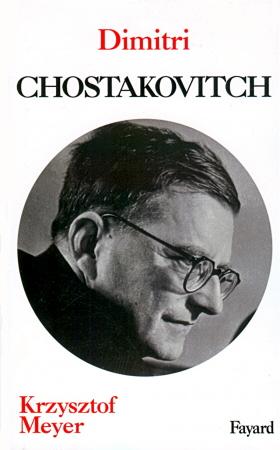
No English translation of Meyer’s book is known to us, but we have procured a copy of the English edition of the June 1975 Sputnik (‘Digest of Soviet Press’). Below is the article by Mikhail Dolgopolov on Shostakovich and Alekhine, from pages 105-107:

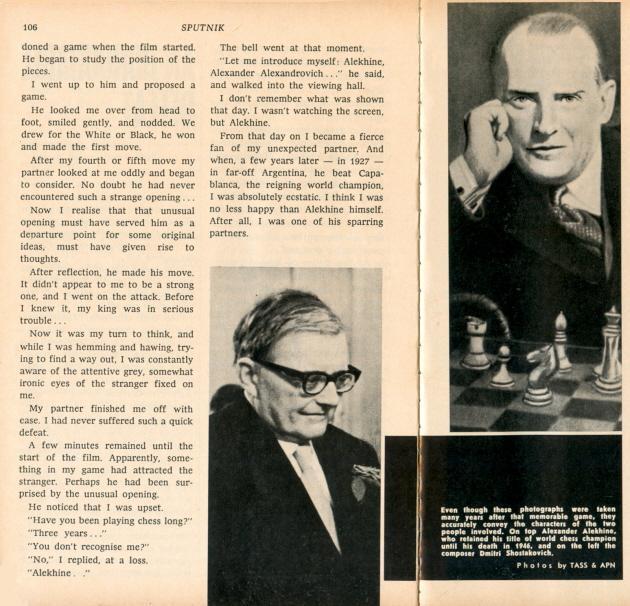
7080. Sämisch v Flohr
The obituary of Salo Flohr on page 8 of the November 1983 Ajedrez de Estilo stated that in 1923 he was defeated in 15 moves by Friedrich Sämisch in a simultaneous blindfold display.
Further information is sought.
7081. Hollywood (C.N. 7076)
Regarding the Pan-American tournament held in Hollywood in 1945, Luc Winants (Boirs, Belgium) provides links to a number of photographs taken by Walter Sanders for Life and available on-line (using the key words chess, Sanders, 1945). Among the high-quality shots are the following:
Page 28 of the 27 August 1945 issue had a photograph of starlets playing on cubes of ice.Linda Darnell and Herman Steiner
Mr Winants also notes this passage from page 211 of The World’s Great Chess Games by R. Fine (New York, 1951):
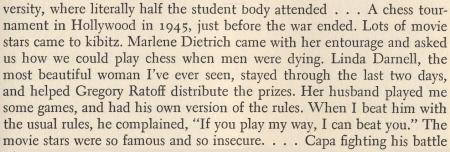
7082. A question of age
Albert Silver (Rio de Janeiro, Brazil) asks:
‘What is the highest age at which a rank amateur (a player with a maximum Elo rating of approximately 2100-2200) climbed the ladder to become an international master or grandmaster? And what is the highest age at which a relatively weak amateur (with an Elo rating no higher than about 1700) made a similar ascent?’
7083. Duped
From page 399 of The Joys of Chess by Christian Hesse (Alkmaar, 2011):
‘All in all Akiba Rubinstein played 1985 tournament games in his life, of which 1763 had rook endgames.’
The book’s author/compiler does not believe in using primary sources or in specifying his secondary sources for particular items (many positions and other material are taken from Chess Notes, in exchange for a one-line mention of our website in a list on page 427). Since The Joys of Chess gives no source for the Rubinstein statistics, we shall do so. The sentence was written by Irving Chernev on the inside front cover of the July 1952 Chess Review, was reproduced on page 270 of his book The Chess Companion (New York, 1968) and was an obvious joke.
7084. ‘Wildly insane’
Our feature article ‘Fun’ quotes from page 44 of CHESS, 14 October 1937 the following piece under the heading ‘What really happened?’:
‘Variations of the following weird theme have appeared in a number of British and American newspapers. We reproduce without comment:“In a chess tournament at Jurata, Poland, a contestant, Willy Frydmann, lost a game then went raving mad.”’
Russell Miller (Vancouver, WA, USA) has found one of those newspaper reports, on page 3 of The Oregonian, 10 June 1937:
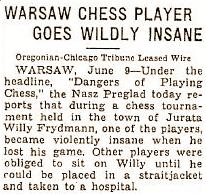
Can a reader find what had appeared in the Polish publication mentioned (whose correct title is Nasz Przegląd)?
7085. Times for individual moves
C.N. 2170 (see page 241 of Kings, Commoners and Knaves) gave our suggestion for the first game in which it is known how much time was consumed on the individual moves: Reshevsky v Alekhine, AVRO, 1938 (CHESS, 14 December 1938, pages 147-149).
Page 8 of CHESS, 21 August 1970 stated:
‘David Bronstein makes no secret of his admiration of our introduction of time records in CHESS in 1938 and 1939 in connection with games in the AVRO tournament.’
Courtesy of a 1968 issue of Soviet Weekly (does any reader have a copy?) CHESS gave the score of Bronstein v Larsen, Amsterdam (Interzonal), 1964:
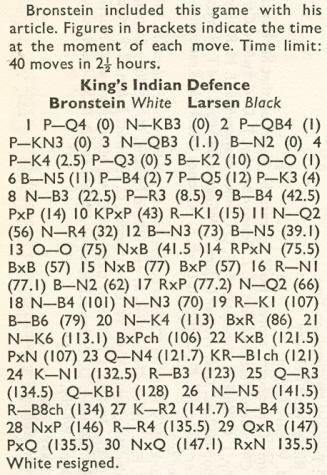
Detailed notes can be found on pages 65-68 of David Bronstein – Chess Improviser by B.S. Vainstein (Oxford, 1983) and on pages 84-91 Larsen’s Selected Games of Chess 1948-69 by Bent Larsen (London, 1970). The latter set of annotations refers on several occasions to the time taken on particular moves.
7086. Lasker-Capablanca reconciliation
John Blackstone (Las Vegas, NV, USA) forwards this report by Emanuel Lasker in the New York Evening Post of 6 June 1914:
‘St Petersburg, 24 May – The last days of the tourney were exciting. I beat Capablanca, and thus obtained an even score with him. A huge crowd followed the game, and applauded enthusiastically at the end. That was six days ago. The next day I had a bye, and Capablanca, whose nerve was evidently shaken, lost to Dr Tarrasch. This gave me a lead of one point. I won an adjourned game with Alekhine, who stubbornly defended a forlorn hope, and so two rounds remained to be finished, in which I had to meet Marshall and Dr Tarrasch, and Capablanca had to face Marshall and Alekhine.
Marshall played well with Capablanca, and obtained a winning advantage. I was exhausted, and I was in the lead, so I did not press matters with Dr Tarrasch, but was satisfied with a draw. Then, suddenly Marshall began to play badly – so badly that he did not even draw. Thus my lead was reduced to half a point. On the last day Capablanca played Alekhine. The two are friends, and Alekhine had nothing to gain by drawing or winning, whereas Capablanca had to win the game at any price. Under these conditions, I had no doubt that Alekhine would be unable to get up the will-power necessary for a hard contest. This is human nature. One cannot fight without a propelling motive. Alekhine, in fact, lost easily and quickly. So I had to beat Marshall to win the first prize. It was a short, sharp contest. Marshall nearly lost by time-limit, but was mated before.
The varying emotions of these eventful days exhausted me, so that I could not even sit down to write to the friendly readers of the Evening Post. Now, though still fatigued, it is with pleasure that I take up the pen again to write the report.
After the games were finished the committee invited the players to meet at 10 p.m. Many amateurs came at the appointed time, and the room presented then the aspect of a meeting. The seven members of the committee sat behind a large table covered with green cloth, with papers and with five souvenirs worked in gold by Caucasian artisans. In a row before the table the five masters sat. And the crowd sat or stood behind and beside them. Many speeches were made in the Russian language. I understood only the names of the players and a few simple words, but the meaning of the orations was fairly evident, as in a pantomime. When my name was uttered the crowd applauded. I shook hands with the committee, signed my name in a book, and received my honorarium and prizes. This ceremony was gone through with all five winners nearly in the same manner.
After that a supper table was prepared. We sat down to an elaborate meal at 11.30. Vodka was drunk out of small glasses, the “Sakuska” was eaten, which consisted of various kinds of hors d’oeuvres, for instance, salads, smoked fish, herring, etc., and then fish and meat were served hot. Then glasses were filled with champagne and toasts were given.
First, the toast on the five winners of the tourney. Then I spoke on the committee, praising their unselfish labors. Then Mr Saburov began a series of toasts to each of the winners, in the order of their rank. I was hailed as the prize-winner, and many came to drink my health. And then Capablanca’s health was drunk. While people were going to shake hands with him, Mrs Lasker came to me and proposed that I shake hands with him, too. And I thought in that moment that he, being vanquished, could not well come to me without humiliation. So I stood up, went to him, and drank his health. And he shook hands with me warmly. Then the diners became frenzied. They crowded round us, and then round Mrs Lasker, hailing her as the peacemaker.
The dinner then became very enjoyable. Everybody was in good spirits, and did his best to entertain the others. And it was four o’clock before Mrs Lasker and myself departed. Many stayed even later, some until seven in the morning, drinking, talking, singing.’
The article was reproduced on pages 149-150 of the July 1914 American Chess Bulletin under the title ‘The Great Reconciliation’.
7087. Chess School (C.N. 7071)
Daniel Naroditsky (Foster City, CA, USA) offers some examples of errors in another tome in the series, Chess School 2 The Manual of Chess Combinations by Sergey Ivashchenko (Moscow, 2002):
1) Page 129 (position 709): ‘Agatov v Kurmashov, Kaliningrad, 1978’:
‘The solution is given as 1…a3 2 Nc1 Ba4 3 Kxd5 Bb3 4 cxb3 a2 5 Nxa2 cxb3 and “Black has a decisive advantage”.
First of all, 3 dxc4 instead of 3 Kxd5 gives White a clear advantage after 3…dxc4 4 Kxc4 followed by 5 Kb4. Secondly, 4 dxc4 too is strong and also gives White a clear advantage (i.e. 4…Bxc2 5 Kd4 and 6 Kc3). Finally, 4…a2 is obviously horrible. 4…cxd3 is the winning move, when White cannot stop Black’s pawns. After 6 Nc3 White has an elementary win.
The simple explanation is that the diagram is wrong; the white pawn should be on c3, not d3. The correct position is given in various endgame books, a recent example being page 412 of Endgame Tactics by G.C. van Perlo (Alkmaar, 2006), which states “Agapov-Kurmasov, Soviet Union, 1978”.’
2) Page 150 (position 831): Averbakh v Bondarevsky, ‘USSR, 1961’:
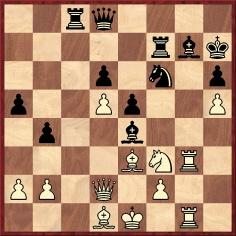
3) Page 151 (position 840): Foltys v Golombek, ‘Prague, 1947’:‘In the book the solution is given as 1 Bxh6 Bxh6 2 Qxh6+ Kxh6 3 Rg6+ Kxh5 4 Nxe5+, etc.
4 R1g5 mate is missed, and there is no mention of the line 3…Bxg6 4 Rxg6+ Kh5 5 Nxe5+ Ng4 6 Bxg4+ Kh4 7 Rh6+ Kg5 8 Nxf7+ Kxg4 9 Nxd8, as given on page 71 of Averbakh’s Selected Games (London, 1998):
In Ivashchenko’s book the game is misdated 1961 (it was played in the USSR Championship in Moscow in 1951), and it is not specified that the position did not occur in the actual game.’
‘The game was played not in Prague but in London (in a match between Great Britain and Czechoslovakia). According to the book, the solution is 1 Rxa6 Rxa6 2 Rb7 Rg7 3 c7 Ra8 4 Rb8 Rg8 5 Rxa8 Rxa8 6 Nd7+ Ke7 7 Nb8. But, of course, 7…Ra1+ followed by 8…Rc1 wins outright. The explanation is that a white pawn is missing in the diagram position. In the actual game Black resigned after the rook capture on a8.’
4) Page 183 (position 1025): ‘Crowl v Fehl, 1962’:
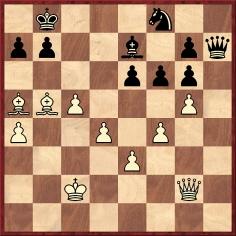
‘According to Ivashchenko, the solution is 1 Qxb7+ Kxb7 2 c6+ Ka8 3 c7 Kb7 4 Ba6+ Kxa6 5 c8(Q)+ Kxa5 6 Qc6 a6 7 Kb3 Nd7 8 Qc7+ Nb6 9 Qc3+.
However, after 6…Qh2+ 7 Kb3 Qe2, there is no mate in sight, and White has to settle for perpetual check. In the starting position, the simple 1 Ba6 bxa6 2 Qc6 leads to a quick mate.’
7088. Sir George Thomas
This autobiographical note by Sir George Thomas comes from page 35 of the February 1935 Chess Review:
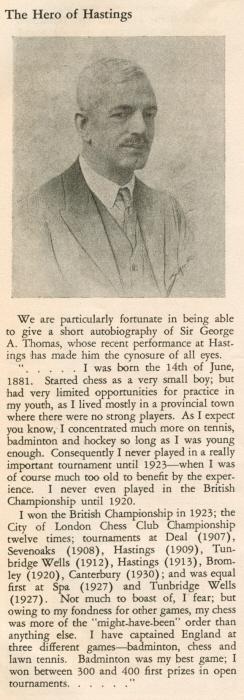
7089. Short v the Badmaster
The following article by G.H. Diggle was given on page 33 of Chess Characters (Geneva, 1984), having originally appeared in the April 1978 Newsflash:
‘The Badmaster (just emerged from long chess hibernation) has actually been “going places” and in good company too. In February he was invited to join 20 or more denizens of the City of London and Fleet Street and take a board against Nigel Short (the world’s top chessplayer of his age) in the “Lloyds Bank City Trophy” simultaneous challenge match.
The event was brilliantly organized and took place in the sumptuous edifice of Salters’ Hall, Barbican. Gone, it seems, are the days when chess and penury walked hand in hand, and “simuls” were economically staged in disused warehouses. Salters’ Hall, with its lofty ceiling and antechambers filled with portraits of past “saline celebrities”, provided an awe-inspiring setting; moreover the Press were there in full force, and their massive photographic apparatus gave the arena the appearance of a large operating theatre.
But this environment did not seem to worry the chief performer in the least. When introduced into our midst by that genial “Ringmaster” Mr L.W. Barden and then left to fend for himself surrounded by four and twenty portly citizens of a great Metropolis, a less cool customer might have exclaimed in the words of the psalmist: “O go not from me, for trouble is hard at hand – fat Bulls of Basan (or, more appropriately, of the Stock Exchange) close me in on every side.” Indeed, the unfeeling “L.W.B.” had in his introductory remarks actually briefed the ferocious oxen not to adopt a defensive stance, but to lower their horns and charge their slender and solitary foe from all directions. It soon became obvious, however, that the youthful matador could look after himself. He began by doling out an assortment of P-K4s, P-Q4s and P-QB4s in quiet “Maundy Thursday” style; and as battle proceeded he appeared (so thought the BM) after the first dozen moves to know, before he reached each board, the precise position that was on it last time he called. Gradually he obtained the upper hand all round; the end of the third hour witnessed the “collapse” of several “stout parties”; and the BM himself, with a bad game and a train to catch, actually fled from the field, only to be warned that his position would be “sat on” by that well-known coroner, the Chess Editor of The Times. (In fact, just as he was sneaking off, that functionary arrived. It was like meeting the undertaker coming up the stairs.) We heard later that the young hero (whose chess manners were as excellent as his chess) had held the ring for four hours and 20 minutes without a break, scoring 23 wins and one draw (against Mr Frank Leonard of the Stock Exchange, who emerged without loss from a complicated “Bull” operation lasting for 40 moves).’
7090. Looking ahead
Our Factfinder lists references to many versions of alleged quotes about seeing only one move ahead. Here is a further specimen, from an article by Leander Turney entitled ‘Chess Instinct’ on pages 208-209 of the September 1914 American Chess Bulletin:
‘It is said that a lady once admiringly asked Zukertort how many moves he could see ahead, and that he replied, “Madam, if the position is sufficiently simple, and I look a long time, I can sometimes see ‘one’ move ahead.”’
The story being prefaced by both ‘it is said’ and ‘once’, particular caution is obviously necessary.
7091. Comment on Salo Flohr
‘Almost impossible to beat but almost incapable of winning.’
Source: page 5 of The Groningen International Chess Tournament 1946 – analyses by M. Euwe commentaries by H. Kmoch (Sutton Coldfield, 1949).
From page 27 of the original Dutch edition, Groningen 1946 (Groningen, 1947):

7092. Lasker’s journey from Switzerland to Germany
John Blackstone (Las Vegas, NV, USA) sends an article by Emanuel Lasker published on page 14 of the New York Evening Post of 16 September 1914:
‘Berlin, 12 August (delayed in transit).
These are eventful days. Germany is almost cut off from communication. It is only by chance that I can hope to get a letter written in English through to America. The only hole in the net is Holland, but I am further handicapped, because the German mail does not handle letters unless they are written in German.
The war came suddenly, like the jump of the lion on the back of its prey. Mrs Lasker and myself were beginning to enjoy Switzerland, when rumors of war started. They immediately spread terror. We stayed in the hope that all might end well, and we fled only just in time. Had we waited one day longer the Swiss, who mobilized their troops, would have closed the railways to the public.
The journey home was a memorable one. In Switzerland it was difficult to change money. German notes dropped in value. Swiss notes were not taken at the railway stations, the tickets had to be paid with the exact amount of their price. It was difficult to get one’s luggage, because so many fled in haste, leaving their luggage at the stations. But all these molestations passed. The entrance into Germany, through Basel, was shut, since Germany feared that France might march her troops through Switzerland and attack the city. The railway was full of Swiss soldiers, who hurried to guard the frontier. We took the route via Lindau, which seemed safe from surprise. And all went well. When we arrived there we thanked God, since in these days the whole world seemed to conspire against Germans.
It took us five days to get from Lindau to Berlin. In time of war the trains move slowly. They are of exceeding length, and soldiers guard every bridge, and inspect every inch of the rails. Every station was crowded with old men, women and children. Those who hurried to be enlisted were everywhere given a rousing welcome. They sang patriotic songs, and when two trains passed each other, the soldiers shouted. It was an inarticulate shouting, clear as a musical note, and strong, somewhat like the noise made by the tempest of a winter’s night.
It was impossible to stay unmoved in this emotion which had seized everyone. The social restrictions were blown away. All Germans were brothers. Here a weeping woman was consoled, there the “reservists”, who were leaving their homes to receive arms and the gray clothes of the soldiers, and to hurry to the front, were given food and cigars. To the soldiers who parted we shouted Auf Wiedersehen, and all women waved their handkerchiefs to them.
Our train neared Berlin on Friday the 7th. When we passed a station not far from Berlin, a man who stood there waved a white paper, an Extrablatt. He was far from us, on another platform of the station, and cried two words, “Lüttich genommen” Lüttich (Liège) fallen. What he said was hardly audible, but we in the train knew it in an instant. A tremendous Hurra then went up. And we arrived in Berlin with an elevated sentiment.
Nobody here doubts that the Germans will conquer. There is some question as to the outcome of the war with England, because the English fleet is numerically far stronger than the German fleet. But the German fleet will fight very well. The Germans are seized by wrath against the Russians. They who have killed for years each day hundreds of their best citizens, who have broken their pledge a thousand times, who have sent out murderers into other countries, attack German culture, and want to ruin it. They will never succeed.’
7093. Evans Gambit/German Game (C.N. 6941)
From page 195 of the Chess Amateur, April 1915:
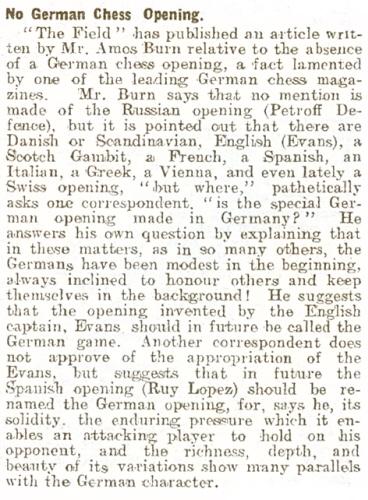
7094. Group photographs
Nigel Nettheim (Cheltenham, NSW, Australia) wonders whether any of the players in these group photographs can be identified:
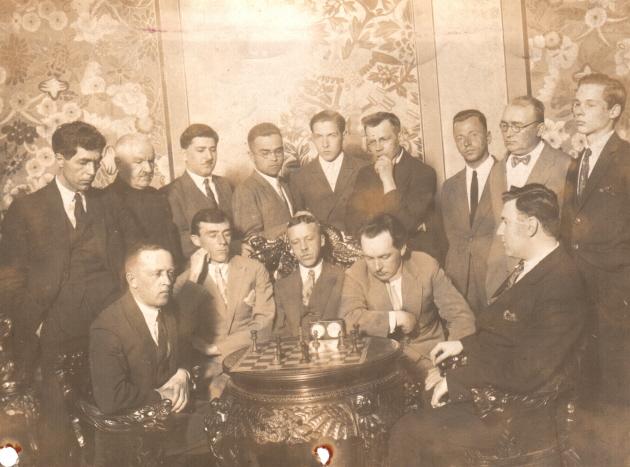
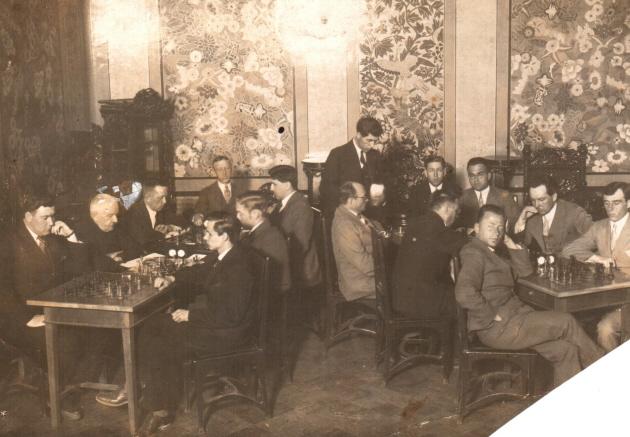
7095. Olivia de Havilland
C.N. 3868 gave a photograph of Olivia de Havilland playing chess against Errol Flynn during the shooting of the 1942 film They Died with Their Boots On. Here is another picture of her, from page 4 of Errol & Olivia by Robert Matzen (Pittsburgh, 2010):
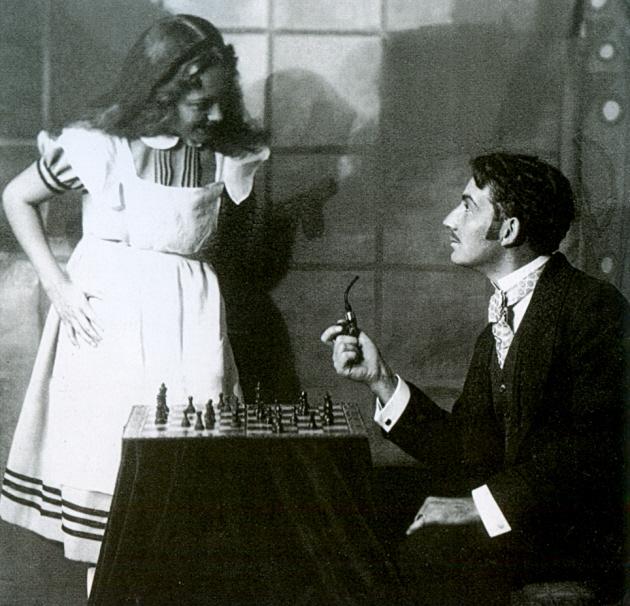
The caption reads: ‘To escape an unhappy home life, Olivia de Havilland finds a creative outlet with the Saratoga Community Theatre. Here, at age 16, she plays Alice in Alice in Wonderland, her first acting role.’
7096. Young v Doré and Atkins v Jacobs
An oft-discussed case of duplication in chess concerns the games Young v Doré, Boston, 1892 and Atkins v Jacobs, London, 1915: 1 e4 e5 2 d4 exd4 3 c3 dxc3 4 Bc4 Nf6 5 Nf3 Nxe4 6 O-O Nd6 7 Nxc3 Nxc4 8 Re1+ Be7 9 Nd5 Nc6 10 Bg5 f6 11 Rc1 b5 12 Rxc4 bxc4 13 Ne5 fxg5 14 Qh5+ g6 15 Nf6+ Bxf6 16 Nxg6+ Qe7 17 Rxe7+ Bxe7 18 Ne5+ Kd8 19 Nf7+ Ke8 20 Nd6+ Kd8 21 Qe8+ Rxe8 22 Nf7 mate.
Young published the game on pages 412-413 of his book The Grand Tactics of Chess (Boston, 1898 and 1905):
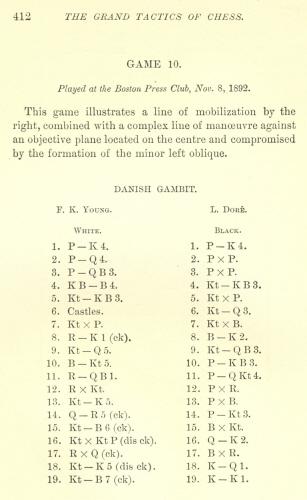
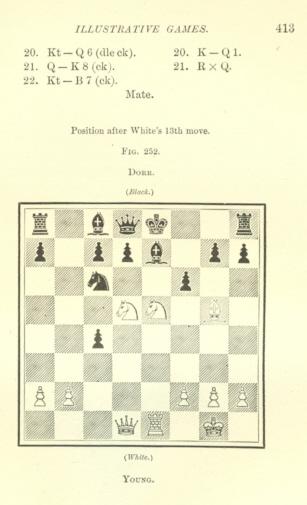
Regarding the Atkins v Jacobs game, we are aware of no publication earlier than pages 85-86 of 200 Miniature Games of Chess by J. du Mont (London, 1941):
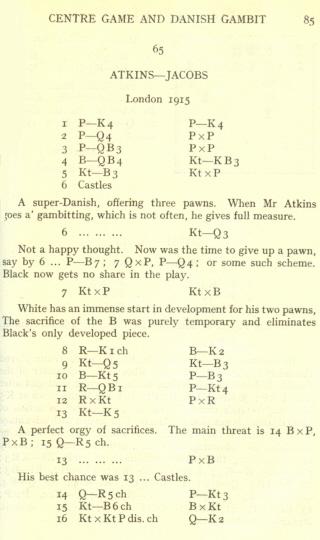
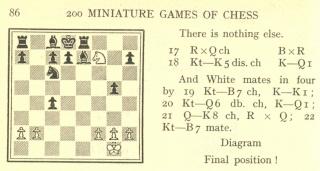
The duplication of the game-score was noted by Walter Korn in an article ‘The Finishing Touch’ on pages 74-75 of the March 1960 Chess Review. He commented:
‘The question is was Atkins in the London Championship knowingly copying from Franklin K. Young, while Jacobs unwittingly aided and abetted him?’
The two games were also included on pages 188-190 of Wonders and Curiosities of Chess by Irving Chernev (New York, 1974). Under the heading ‘Chernev experiences psychic phenomenon’ the author stated that while playing over the Young game he had received a telephone call from a friend regarding the Atkins version.
From K.Whyld’s Quotes and Queries column on page 406 of the September 1979 BCM:
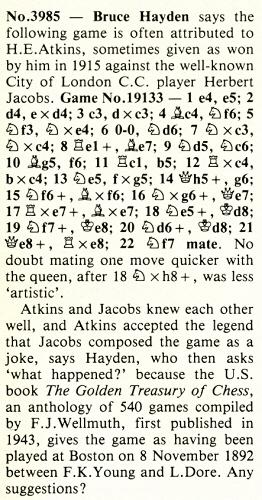
It will be noted that no evidence, let alone proof, was proposed for the suggestion that the game was a joke.
On page 475 of the October 1991 BCM Whyld mentioned again Hayden’s reference to a joke involving H.E. Atkins and H. Jacobs but then speculated as follows:
‘My conclusion is that the game was played twice; Young-Doré, and M.G. Atkins-Jacobs, London Championship 1915-16. Michael Glover Atkins was killed in the war towards the end of 1916, and was not around to give his account of the game, when it became controversial.’
M.G. Atkins did indeed defeat Jacobs in the 1915-16 City of London Championship, as is shown by the crosstable on page 175 of the May 1916 BCM. Atkins’ obituary was published on page 401 of the December 1916 BCM and on pages 65-66 of the December 1916 Chess Amateur. Page 98 of the January 1917 Chess Amateur stated: ‘Though slightly over military age, he patriotically volunteered for service, and has now met his death.’
As shown above, du Mont’s book had only the surnames Atkins and Jacobs in the game heading. The respective forenames Henry Ernest and Herbert appeared solely in the index, and the possibility of a mix-up between two players named Atkins cannot be excluded. In C.N. 2623 (see page 164 of A Chess Omnibus) we wrote in another context:
‘Pages 451-452 of the Chess Amateur, December 1911 had a description of Capablanca’s first two simultaneous exhibitions in England (at the City of London Chess Club on 15 November and at the Imperial Chess Club two days later). In the first display his opponents included J.H. Blake, H.G. Cole, R.J. Loman and O.C. Müller, but it would seem that The Unknown Capablanca by D. Hooper and D. Brandreth erred by stating (on page 146) that among the participants was also “one grandmaster, H.E. Atkins”. Neither the Chess Amateur report nor the account in the BCM (December 1911 issue, pages 474-475) mentioned H.E. Atkins, but both stated that a board was taken by M.G. Atkins.’
It may be added that M.G. Atkins’ obituary on page 401 of the December 1916 BCM said that ‘he was one of those who defeated Capablanca in his simultaneous exhibition at the City club, on 13 October 1913’.
On 11 December 1973, a couple of months before he died, C.H.O’D. Alexander wrote us a letter about the Danish Gambit game:
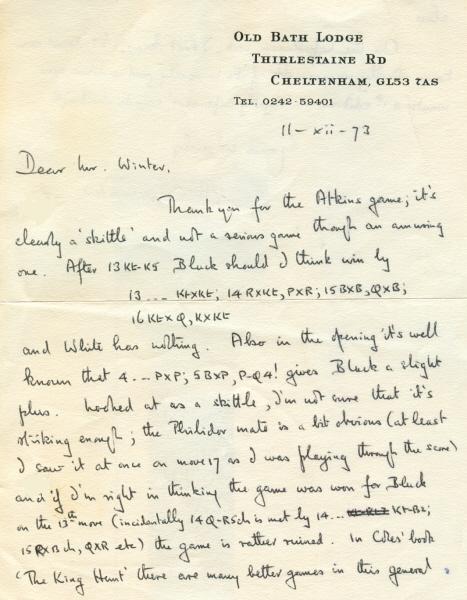
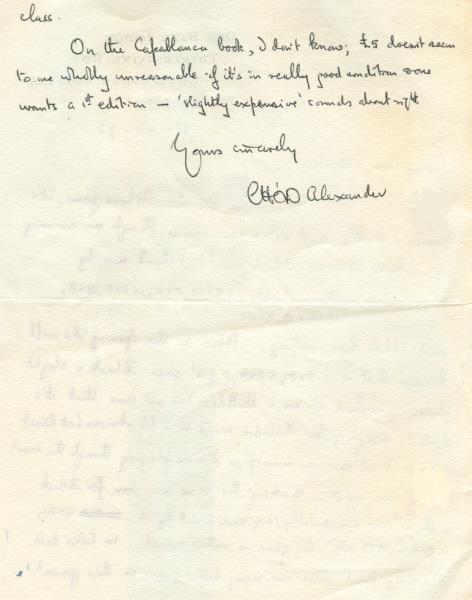
By ‘Coles’, of course, Cozens was meant. See too in this
connection page 587 of the December 1979 BCM,
which also referred to Chernev and his ‘psychic
phenomenon’.
In the early twentieth century the Young v Doré game received two small bursts of publicity, in 1903 and 1915. A number of magazines in 1903 reproduced the score from The Times (exact source?), an example being page 202 of the May 1903 issue of the Belgian periodical Revue d’échecs:
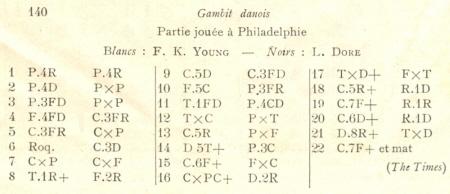
It will be noted that the venue was specified as Philadelphia rather than Boston.
The game’s publication in The Times in 1903 was
also mentioned by A. Keiner of Meiningen on page 302 of Deutsches
Wochenschach, 24 October 1915. Young v Doré had been
given on page 287 of the 10 October 1915 magazine, taken
from the BCM (page 281 of the August 1915 issue).
It was contributed to the BCM by C.F. Davie of
Victoria, British Columbia. No source was supplied, but on
pages 357-358 of the October 1915 BCM he gave two
further games (Young v Pillsbury and Young v Snow) which
are also in Young’s book The Grand Tactics of Chess.
Can it really be a coincidence that the year (1915) in
which Young v Doré was quite widely published was the same
year in which, according to du Mont, the game
Atkins-Jacobs occurred?
About L. Doré we can offer no biographical information, but the following passage on pages 58-59 of America’s Chess Heritage by Walter Korn (New York, 1978) is worthy of note and investigation:
‘Franklin Young’s games were pretty ones, but he played another significant role as well. He was a member of the Boston group of chess enthusiasts, consisting of J.F. Barry, C.F. Burille, L. Dore, H.N. Stone, P. Ware Jr., and others, who called themselves “The Mandarins of the Yellow Button”, a minute allusion to the German seven-master group, “The Pleiades”, of the 1850s.’
In view of the multiple loose ends, it would seem unwise to put forward any conclusions at present about either Young v Doré or Atkins v Jacobs.
7097. Capablanca before New York, 1924
Olimpiu G. Urcan sends this article from the 16 March 1924 issue of the Brooklyn Daily Eagle (page A11):
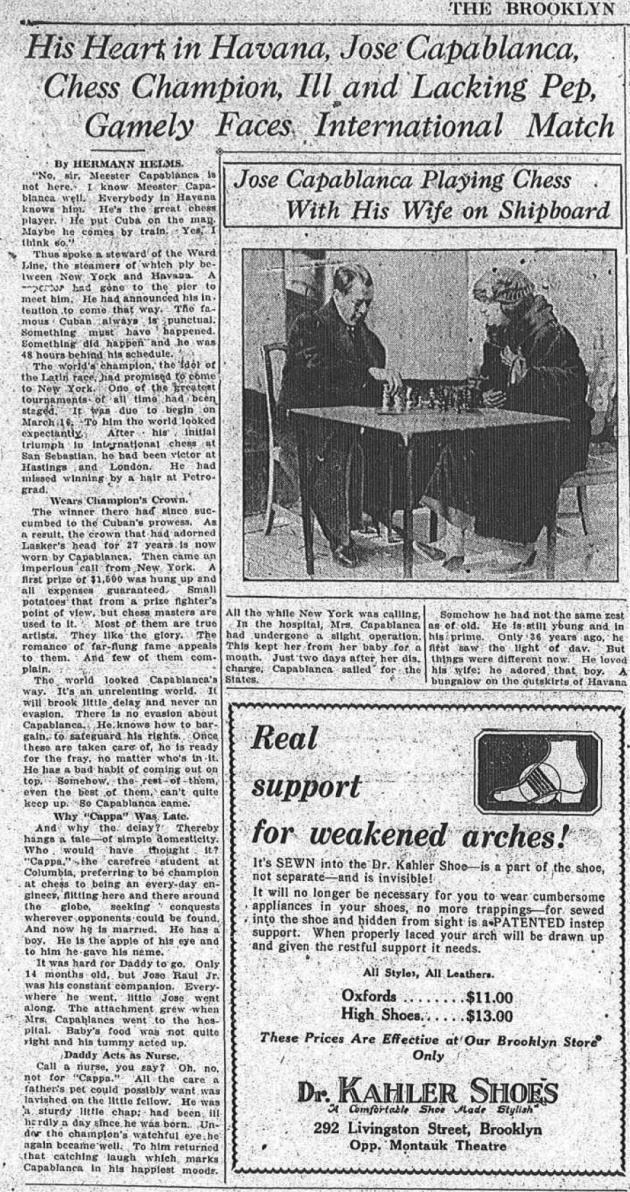
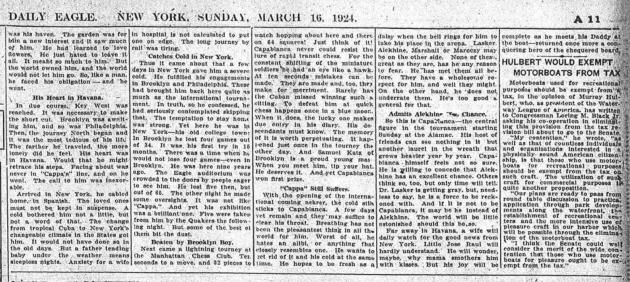
Larger version of the second part
7098. A rare gambit
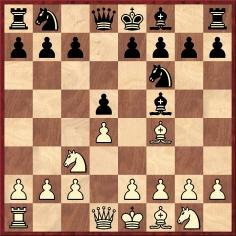
White played 4 g4
As mentioned in C.N. 2502 (see page 180 of A Chess
Omnibus), a game beginning 1 d4 d5 2 Nc3 Nf6 3 Bf4
Bf5 4 g4 (in which Pillsbury gave king’s rook odds to a
player identified only by the initial H.) was published
on pages 121-122 of the American Chess Monthly,
July 1892. The game ‘was played some time ago’ and with
regard to the opening the magazine said: ‘Mr Pillsbury
lays claim to the invention of it, but I think its
similarity to a well-known opening detracts considerably
from its originality.’
The complete score as published in the American Chess Monthly:
1 d4 d5 2 Nc3 Nf6 3 Bf4 Bf5 4 g4 Bxg4 5 f3 Bh5 6 Qd2 Nbd7 7 O-O-O c5 8 e4 cxd4 9 Qxd4 dxe4 10 Bb5 exf3 11 Nd5 Nxd5 12 Qxd5 Bg4 13 Nxf3
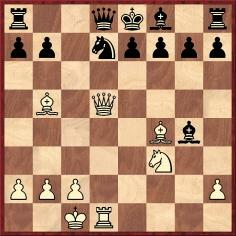
13...Rc8 14 Ne5 Be6 15 Nxd7 Bxd5 16 Nf6 mate.
C.N. 2502 remarked that page 266 of Harry Nelson Pillsbury American Chess Champion by Jacques N. Pope (Ann Arbor, 1996) dated the game 1895. We add here that the book specified as its source Chigorin’s column in Novoye Vremya of 12 December 1895. The moves from 13...Rc8 to 16 Nf6 mate appeared in a note, and the game’s finish was stated to be 13...Be6 14 Qxe6 fxe6 15 Ne5 Qa5 and ‘White mates in two’.
| First column | << previous | Archives [82] | next >> | Current column |
Copyright: Edward Winter. All rights reserved.
